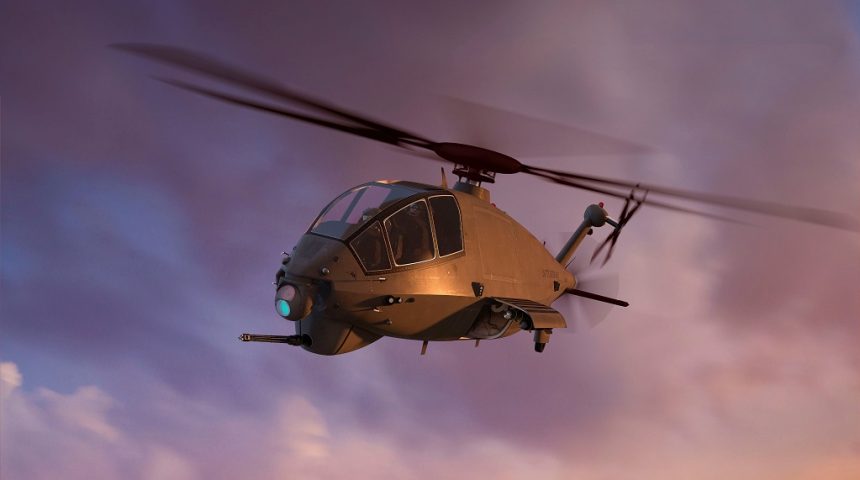Boeing unveiled its design for the Future Attack Reconnaissance Aircraft. Now that all candidates are public, let’s see what we know about the helicopters that could replace the OH-58D Kiowa Warrior.
On Mar. 3, 2020, Boeing unveiled its design for the Future Attack Reconnaissance Aircraft (FARA) of the U.S. Army. Boeing was the last company to present its candidate, so we can now finally talk about what we know of the five candidates. Let’s start from the beginning.
The FARA program was launched in 2018 to develop a successor to the Bell OH-58D Kiowa Warrior scout helicopter, retired in 2014, as part of the Future Vertical Lift program. Currently, this capability is provided by manned-unmanned teams of AH-64E Apache Guardian helicopters and RQ-7B Shadow Unmanned Aerial Systems. This is the fourth time the service tries to replace the OH-58, as the previous programs never reached the production stage. According to official statements, the service is also looking to replace nearly half of the AH-64 Apache fleet with the new FARA.
The U.S. Army is proceeding on an accelerated schedule, with the aim to field the new aircraft by 2028. In April 2019, design contracts were awarded to five manufacturers: Boeing, Bell Helicopters, Sikorsky Aircraft, Karem Aircraft and the joint AVX Aircraft/L3 Harris Technologies partnership. The manufacturers were to present their design by February 2020. After that deadline, two of them will be selected to proceed to the next phase and build the first prototypes that will fly in 2023.
According to the mandatory requirements, FARA candidates will use the General Electric T901 engine, selected under the Improved Turbine Engine Program (ITEP), and the General Dynamics XM915 20mm cannon. The maximum dimensions should not exceed 40 foot (12 m) for both rotor diameter and fuselage width, and the aircraft should meet a minimum speed of 180 knots and a maximum speed of 205 knots, range of 135 nm, 90-minute on station endurance, 4000 feet/95 F Hover Out of Ground Effect (HOGE), a unspecified target gross weight and payload and an affordability goal. Another requirement is a pilot-optional capability that could be further exploited in future and a Modern Open Systems Architecture (MOSA) to be able to easily upgrade the aircraft.
Take a look at #BoeingFARA! This agile helicopter is purpose-built for the @USArmy’s evolving missions. pic.twitter.com/0JeHzrQqdT
— Boeing Defense (@BoeingDefense) March 3, 2020
The last candidate to be presented to the public is the Boeing proposal, which has been called simply Boeing FARA. The new design is a compound helicopter with three different rotors: a six-bladed “high-solidity” main rotor, a canted conventional four-bladed anti-torque tail rotor and a four-bladed pusher prop in the rear, all powered by a single T901 engine with the air intake on the right side of the fuselage. Shane Openshaw, Boeing’s FARA program manager, justified the choice by saying: “The high-solidity rotor, think of it as a mean to provide the agility and maneuverability this aircraft requires. The tail rotor, conventionally, will give it maneuverability characteristics at lower speed of a more typical helicopter and in partnership with that propeller on the back, it will give it the speed and maneuverability needed to support the FARA requirement.”
Openshaw also explained to FlightGlobal’s reporters that there’s a clutch in the drive train behind the intermediate gearbox that drives the tail rotor, adding power to the configuration, and the aircraft will be able this way to maintain airspeed during maneuvers that would cause other helicopters to lose airspeed. This way, the FARA design will be able to meet both the speed and the HOGE requirements.
According to the press release, the helicopter includes a MOSA state-of-the-art cockpit with a reconfigurable large area display and autonomous capabilities. The design doesn’t have lift sharing stub wings like other design participating in the competition. From what can be seen in the concept arts, the helicopter will have internal weapon bays, a turret for the 20 mm cannon coupled with a FLIR system and multiple sensors related to the Missile Approach Warning System (MAWS).
The lines of Boeing’s design are reminiscent of both the AH-56 Cheyenne, especially if we look at the three rotors design, and the RAH-66 Comanche, if we look at the stealthy and canted fuselage. Stealth, however, wasn’t the goal of this design, as the canted lines are a result of the focus on a high-speed, low drag configuration.
Even if this should be the first Boeing clean sheet design helicopter since the RAH-66 program, Openshaw stated that they are not developing new technologies for it, but rather they are improving and integrating existing mature technologies to reduce cost and risk, while also remaining on schedule.
In October 2019, Bell announced the 360 Invictus as its FARA candidate design. The Invictus features a rather conventional configuration with a single fully articulated main rotor and a ducted tail rotor. Much like Boeing, Bell decided to use proven technologies to reduce risk and cost, as the Invictus makes use of a scaled down main rotor from the Bell 525 Relentless and its fly-by-wire controls.
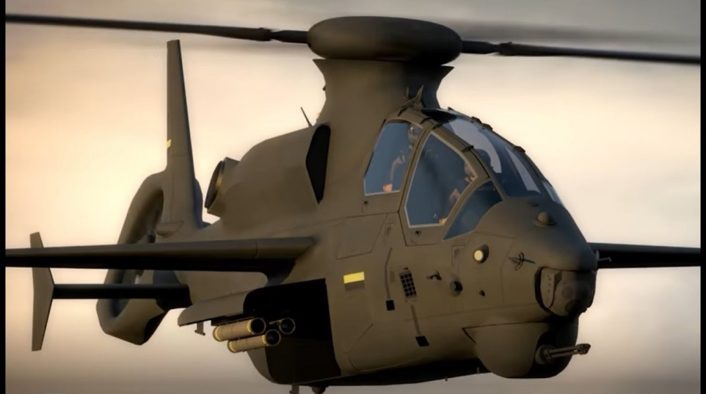
According to Bell, the five-bladed rotor of the 525 reached speeds in excess of 200 knots during flight testing. The four-blade rotor of the Invictus should reach more than 185 knots, while the Army’s requirement is for a cruise speed of at least 180 knots. The helicopter features also a lift sharing stub wing with a wingspan of 24 foot (about 7.5 m) that should provide up to 50% of the lift while at cruise speed. The canted tail rotor should provide additional lift while hovering and reduce the drag during cruise. Another drag reduction feature is provided by the flight control system that is designed to automatically trim the helicopter in the lowest drag position.
Affordable. Sustainable. Lethal. The #Bell360 Invictus is designed as a sustainable and reliable solution. #ArmyModernization #FVL #FARA pic.twitter.com/gGQJl9sr4e
— Bell (@BellFlight) February 4, 2020
The Invictus is powered by a single T901 engine mounted asymmetrically on the left side of the rotor, while its exhaust is located on the right-hand side. This choice is justified by the fact that on the right side there is a Pratt&Whitney Canada PW207D1 (the same engine used by the Bell 429) acting as a Supplemental Power Unit (SPU), that will engage with the drive system to provide additional horsepower when extra speed is needed during forward flight, according to Keith Flail, vice president of Advanced Vertical Lift Systems at Bell, meeting all the performance requirements.
Similarly to Boeing’s FARA, the Invictus features internal weapon bays, a turret with a 20 mm cannon coupled with a FLIR system and a multitude of sensors related to the MAWS. The stub wings can also be configured to carry weapons if needed. The helicopter features a MOSA avionics, provided by Collins Aerospace, and there are also provisions for future autonomous flight capabilities.
As already noted in a previous article here at The Aviationist, the Invictus’ design is highly reminiscent of the RAH-66 Comanche but, again, stealth is not the defining factor behind this design. “Everything we have done has been focused on how do you keep the lowest drag possible on the aircraft, so we don’t have to add exotic solutions to the aircraft the meet the requirements to get the speeds that you need for the FARA program”, said Flail during the presentation.
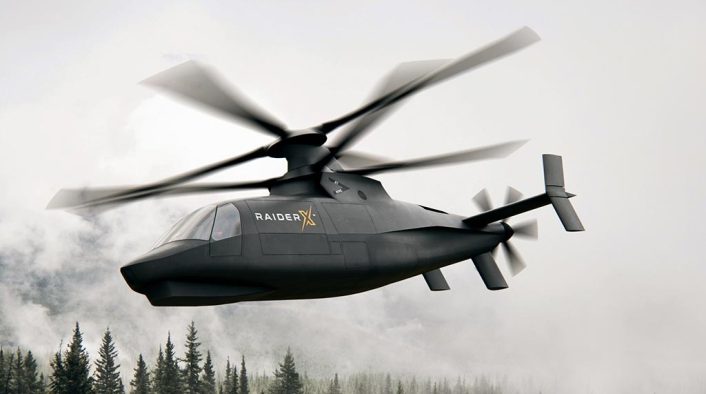
A few days after Bell, Sikorsky unveiled its own design for FARA, a scaled-up version of its S-97 Raider coaxial compound helicopter, called Raider X. The Raider X will be 20% larger than the S-97, with the main rotor going from a 34 foot (10.4 m) diameter to a 39 foot (11.9 m) diameter and the weight increased from 12,000 pounds to 14,000 pounds (5,445 to 6,350 kg).
Like its competitors, the Raider X uses a single T901 engine that could propel the helicopter well over the 180 knots requirement, as the less powerful S-97 already reached 207 knots in level flight and 250 in a shallow dive during testing. The engine appears to be mounted in a classic central position, with air intakes on both sides and the exhaust contained in the tail boom.
The Raider X features a side-by-side cockpit, which also widens the fuselage for an increase of the payload carried in the internal weapon bays, with MOSA-based avionics and mission systems, according to Sikorsky. It’s not clear yet were the internal weapon bays are located, as they are not shown open in any official image, however they could be located under the two big doors shown just behind the cockpit.
The concept arts for the design show a very sleek profile that could be a consequence of low-observability considerations, as there are no protruding components like sensors or antennas. Even the cannon seems to be contained in a closed fairing under the cockpit when not needed. However, as noted for Boeing’s and Bell’s designs, the sleek profile may be derived solely from drag reduction considerations, as stealth in not a requirement for FARA.
Karem Aircraft, in partnership with Northrop Grumman and Raytheon, unveiled its design, called AR40, almost at the same time of Sikorsky. As a side note, the company was founded by Abraham Karem, the designer of the GNAT 750 UAV, which later evolved into the General Atomics MQ-1 Predator.
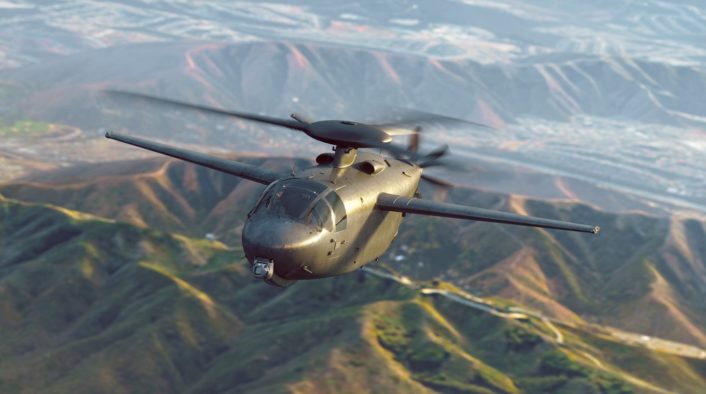
The AR40 is a compound helicopter with a rigid three-blade main rotor, a swiveling tail rotor and pivoting wings. The 40-foot-wide main rotor is said to use Karem’s Optimum Speed Rotor technology, which controls each individual blade to optimize the pitch continually during the flight, reducing vibrations at high speeds. The tail rotor can act as both an anti-torque rotor, if oriented sideways while hovering, or a pusher propeller, if oriented backwards during high speed flight.
The pivoting wings match the main rotor diameter and act as lift sharing wings to reduce the load on the rotor. “A larger wing gives you a lot of area to provide lift and the more lift you can get on the wing at high speed, or even moderate speed, the less you have to put on the rotor. That buys you dynamics and efficiency. If I don’t carry load on the rotor, that means the blades are de-pitched and are going to move way more efficiently through the air”, said Karem’s FARA program manager Thomas Berger.
As the Raider X, the AR40 features a side-by-side cockpit to promote crew coordination and to increase the space in the fuselage for avionics, mission equipment and payload. According to Berger, the additional space behind the cockpit could be used also to carry passengers, much like the Russian Mi-24 Hind.
As the other competitors, the AR40 uses a single T901 engine. Like the Raider X, the engine is mounted centrally with two air intakes on the sides and the exhaust buried in the tail boom. Karem is confident that the AR40 should be able to exceed the US Army’s 180kt requirement by 40kt. The design is not as sleek as Sikorsky’s, but at least it seems to use a similar fairing to hide the cannon, leaving only the FLIR turret exposed.
The FARA design proposed by the partnership between AVX Aircraft Company and L3 Technologies, called Compound Coaxial Helicopter (CCH), was the first to be unveiled in April 2019. The design uses two coaxial counter-rotating flexible main rotors and two ducted pusher fans on the sides of the fuselage that should provide both forward and reverse thrust. The fans are always active during every phase of flight. As for Sikorsky’s and Karem’s designs, the CCH has a single T901 engine mounted centrally with two air intakes on the sides and exhaust buried into the tail boom.
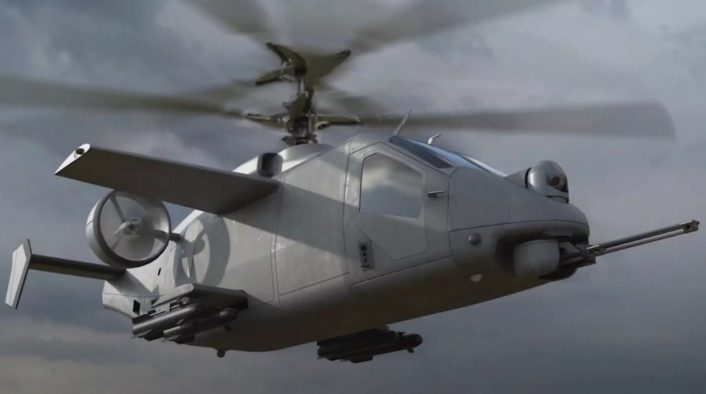
According to chief executive Troy Gaffey, AVX used data provided by the Russian helicopter maker Kamov to reduce the separation between the rotors and offer a lighter attack aircraft than others with rigid rotors, similarly to what Kamov did with its Ka-50 Black Shark, the world’s first operational helicopter with an ejection seat and single seat version of the Ka-52 “Alligator”. Gaffey told to Vertical Magazine’s reporters: “The Russians have been flying coaxials for years. Surprisingly, they’ve been very open with their technology. They have presented technical papers at various meetings and one of the subject matters they have investigated is the clearance between the rotors. They have developed a criteria for clearance that works.”
AVX’s design also uses a lift sharing wing for forward flight. According to the company, the CCH should be capable of a cruise speed in excess of 200 knots.
The CCH features a side-by-side cockpit, but this time it looks like the choice is not due to the internal weapon bays, as the helicopter seems to be carrying its weapons only externally on two stub wings positioned below the two lift sharing wings. The cockpit is said to be optimized for pilot efficiency and uses MOSA technology and fly-by-wire flight controls. The concept art shows a turret for the 20mm cannon and the FLIR system in front of the cockpit and some unidentified sensors that could be associated to MAWS.
The company didn’t mention how they are addressing the radar and infrared signature reduction, rather focusing on another interesting feature of the design, as the form factor of the CCH has been designed to meet C-17 cargo and Arleigh Burke-class destroyers size limits through folding rotors and wings.
Should we want to compare the different FARA candidates, Boeing and Bell seem to be the lower-cost/lower-risk designs that are able to meet the complex requirements set for the competition. If we look at past armed reconnaissance helicopters, they were fairly simple, light and reliable designs that made of their speed, agility and small size their best way to survive and complete the mission.
Designs like Sikorsky’s, Karem’s and AVX’s may provide performance well in excess of the Army’s requirement, but they also represent more complex solutions that could come with increased costs for both acquisition and operation. In an era of continuous defense budget cuts, higher costs could represent a limiting factor, especially if we consider that the U.S. Army is working also on other big programs at the same time, like the Future Long-Range Assault Aircraft to replace the UH-60M Blackhawk, the Next Generation Squad Weapon to replace the M-4 carbine and the M-249 light machine gun, and the Improved Turbine Engine Program to replace the engines of the entire Blackhawk and Apache fleets, to name some. Whatever will be the winning design, the Army’s choice can be expected as early as this month.

